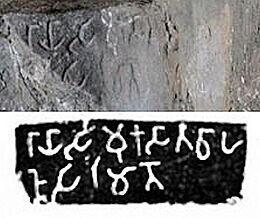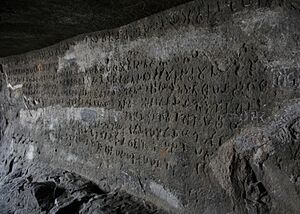Simuka facts for kids
Quick facts for kids Simuka |
|
|---|---|

The Simuka inscription (photograph and rubbing) at the Naneghat Caves, in early Brahmi script:
𑀭𑀸𑀬𑀸 𑀲𑀺𑀫𑀼𑀓 𑀲𑀸𑀢𑀯𑀸𑀳𑀦𑁄 𑀲𑀺𑀭𑀺𑀫𑀢𑁄 Rāyā Simuka - Sātavāhano sirimato "King Simuka Satavahana, the illustrious one" |
|
| Founder of Satavahana dynasty | |
| Reign | 1st century BCE |
| Successor | Kanha |
| Issue | Satakarni |
| Dynasty | Satavahana |
| Religion | Hinduism |
Simuka was an ancient Indian king. He founded the Satavahana dynasty. This powerful family ruled the Deccan region of India. People know him as the first king of this dynasty. His name appears in old writings. These writings are called inscriptions. One important inscription is at Naneghat. Ancient books called the Puranas also mention him. His name is spelled in different ways in these books. This is because copies were made over many years.
Historians are not completely sure when Simuka lived. Some think he lived in the 3rd century BCE. However, most believe he ruled in the 1st century BCE. Old inscriptions help us figure this out. The Naneghat inscription mentions Simuka. It suggests he was the father of King Satakarni. This inscription dates back to around 70-60 BCE. Another inscription from Nasik Caves mentions Kanha. Kanha was likely Simuka's brother. This inscription is from 100-70 BCE. Based on these clues, Simuka's rule might have been around 120 to 96 BCE.
Simuka's Time Period
Simuka is listed as the first king in a Satavahana inscription. This inscription is found at Naneghat. Different ancient texts, called the Puranas, name the founder of the Andhra dynasty in various ways. For example, he is called Shishuka in the Matsya Purana. In the Vishnu Purana, he is Sipraka. These different spellings likely happened when copies of the texts were made over time.
Some Puranas say that the first Andhra king overthrew King Susharman. Susharman was the last ruler of the Kanva dynasty. This happened around 30 BCE. If Simuka was this king, then his rule would have started around 30 BCE. Many historians support this idea.
However, other historians have different ideas. The Matsya Purana says the Andhra dynasty ruled for 450 years. The Satavahana rule lasted until the early 3rd century CE. This means their rule might have begun much earlier. It could have started in the 3rd or 2nd century BCE. An ancient Greek writer named Megasthenes also wrote about a powerful tribe. He called them "Andarae." This tribe had a large army. If "Andarae" refers to the Andhras (Satavahanas), it suggests their rule began early. This would mean Simuka ruled soon after the Mauryan emperor Ashoka.
Some scholars believe Simuka brought the Satavahana rule back to power. This happened after the Kanva dynasty had taken over. So, Simuka might have been the founder of a 'second' Satavahana dynasty. Coin evidence also suggests Simuka's rule ended before 120 BCE. Recent studies place his reign between 120 and 96 BCE.
About Simuka's Life
We do not know much about Simuka's personal life. Some old stories say he followed Jainism. But later in his life, he became a harsh ruler. Because of this, he was removed from power and killed.
The Puranas say that the first king of the Andhra (Satavahana) dynasty killed the last king of the Kanva dynasty. This allowed the Satavahanas to take control. The Puranas state that Simuka attacked the Kanvas. He also destroyed what was left of the Shunga dynasty. This helped him gain control of the land. In some texts, he is also called Balipuccha.
Simuka's brother, Kanha, became king after him. Kanha expanded the empire further west. He reached at least as far as Nashik. An inscription found there mentions Kanha. The Matsya Purana says Krishna (Kanha) was followed by Mallakarni. But other Puranas say Satakarni became king after Kanha. The Naneghat cave inscription lists Simuka's name. It does not mention Kanha. Based on this, historians believe Satakarni was Simuka's son. They think Satakarni became king after Kanha.


